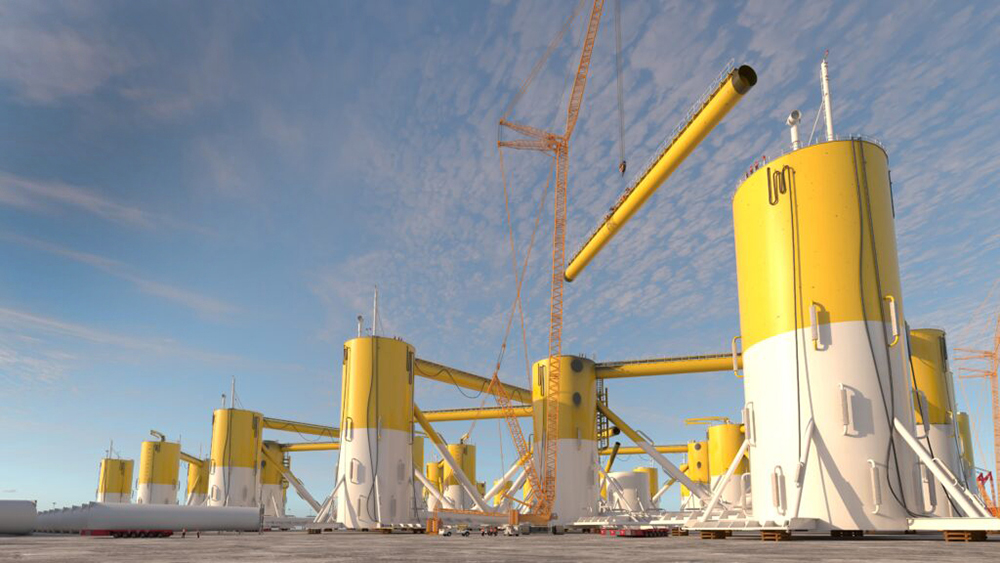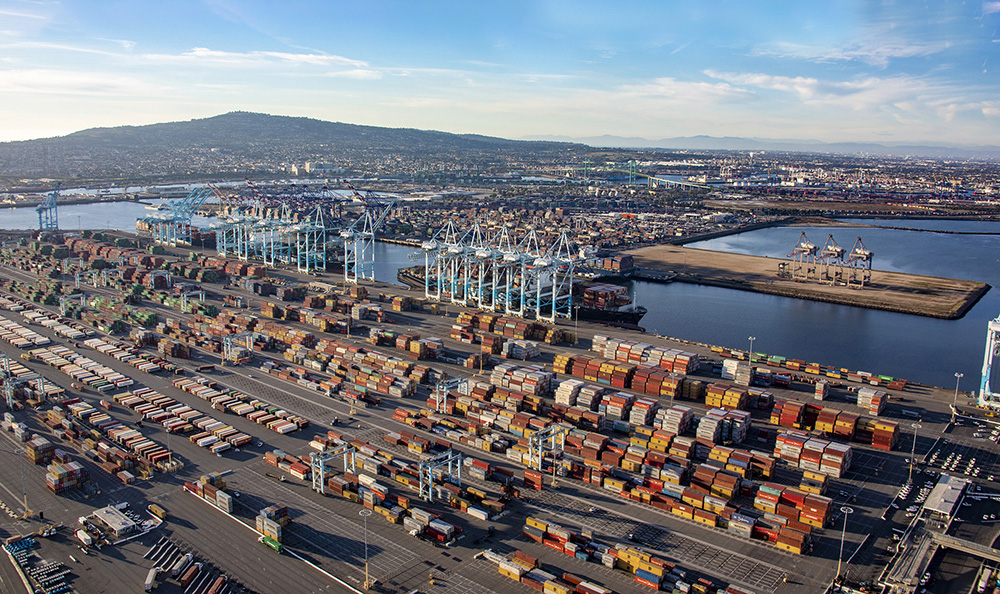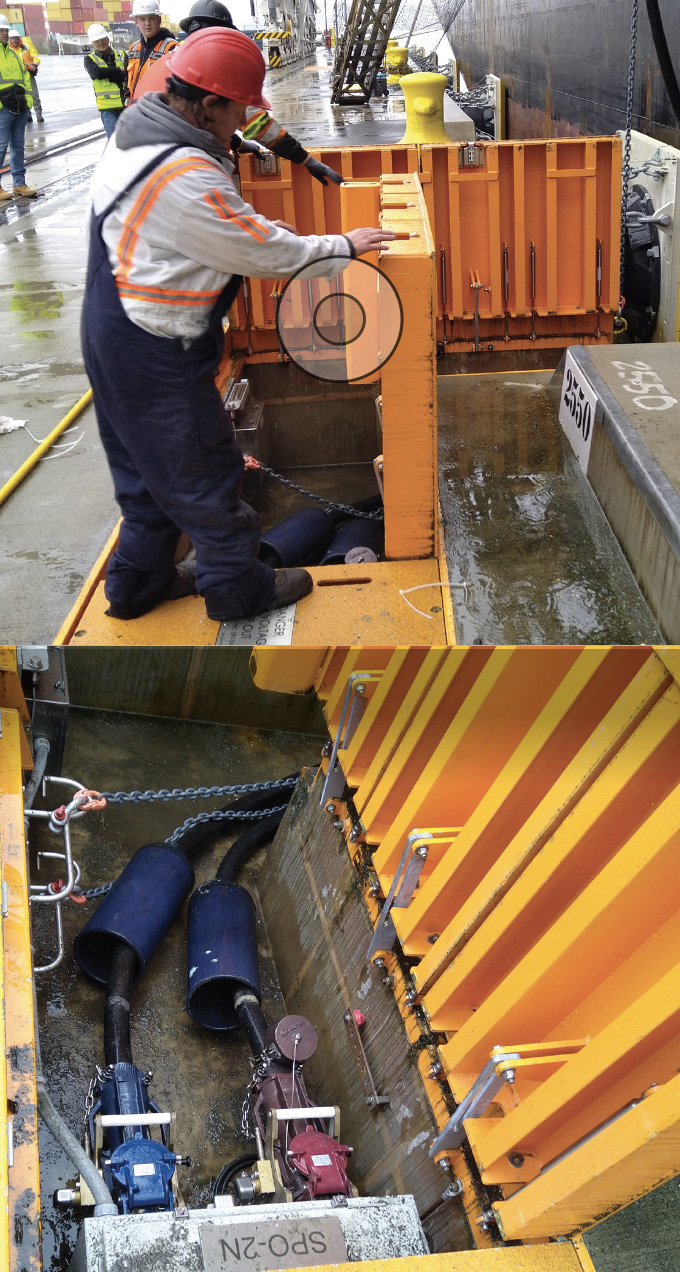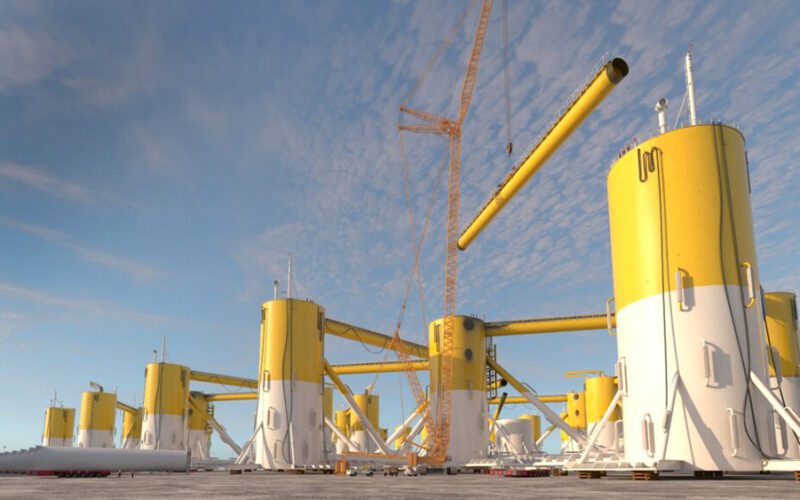
For years, West Coast seaports have been investing in infrastructure to meet evolving needs, whether it’s the arrival of larger vessels and the massive cargo volumes that came with them or the rising use of technology and awareness of sustainability.
Hundreds of millions of dollars are being spent from the public and private sectors to stay competitive, at a time when investments at other North American seaports are growing and the battle for market share is fiercer than ever.
“Federal and state governments have dedicated an unprecedented amount of funding for infrastructure,” Port of Oakland Executive Director Danny Wan said at Oakland’s annual State of the Port event earlier this year. “We have a once-in-a-lifetime opportunity to apply for these government funds to build new facilities and clean energy infrastructure.”
Here’s a look at infrastructure projects being planned or in progress at the biggest West Coast ports in North America: Los Angeles, Long Beach, Vancouver (BC), Seattle-Tacoma and Oakland.
Port of Los Angeles
The Port of Los Angeles has been advancing on a number of infrastructure projects, including two that are under construction.

The port’s building a new $44.8 million marine oil platform at the Shell Oil Terminal, a project that calls for removing timber wharves and building and operating a new wharf at Berth 168. In addition, small improvements to link the new loading platform to current landside pipelines and utilities are planned. The project is set to be completed in 2024.
Also under construction is the Pier 400 Corridor Storage Tracks Expansion Project, which would allow the port to meet future rail business on Terminal Island. The project features a concrete rail bridge with lighting, a half-dozen new rail storage tracks, an asphalt access road, new crossovers and switches and changes to the current compressed air system.
The port plans to relocate part of the Pier 400 lead track onto port property and realign the track link to the current rail storage yard, as well as making changes to Reeves Avenue and moving the current at-grade crossing at Nimitz Avenue to Reeves Avenue.
The $72.3 million project, set for completion in 2024, is funded with $1.6 million from the California Trade Corridor Enhancement Program.
Bids are due in June for work on the $11.4 million Berths 177-78 Wharf Restoration project, which consists of building about 382 linear feet of concrete wharf and making seismic improvements. Construction is expected to begin this year.
The port’s planning to make improvements to one of the area’s most important interchanges, with about $110 million being invested in the state Route 47/Vincent Thomas Bridge and Front Street/Harbor Boulevard Interchange Reconfiguration project. Construction is anticipated to start by early 2024.
The project involves removing the current westbound off-ramp from the Vincent Thomas Bridge on the south side and replacing it with a new one on the north side, as well as other realignment and modifications.
The port’s also finalizing the designs of several projects that officials hope to begin construction on later this year, including a new $35 million marine oil platform at the PBF Energy Oil Terminal, which features a new unloading platform measuring 125 feet by 58 feet at Berth 238, as well as berthing and mooring dolphins, catwalks and access ramps.
The work, expected to begin in August, involves demolishing two unloading platforms at Berths 238 and 239, and other mooring and berthing dolphins.
The port is also wrapping up plans for the $256-million Berth 306 Wharf Expansion, which would help Fenix Marine Services to meet increased capacity. The project, set to start at the end of the year, calls for creating 1,250 linear feet of 100-gauge concrete wharf, 200 feet of dredging to below 55 feet at Berth 305 and 2.2 acres of container terminal backland. There also will be added “high voltage electrical infrastructure” for two dozen ship-to-shore cranes from Berths 301-306.
Also in design phase is a $52.3 million project to expand a railyard at Berths 302-305, a move that not only is expected to enhance on-dock rail yard capacity by 10%, but also improves surrounding infrastructure, the port said.
Construction, which would add about 16,200 linear feet of track in five new loading tracks and one tail track, is expected to start by the end of this year.
The POLA is also working on the $38.7 million Berths 302-305 On-Dock Railyard Expansion project. Work, which officials hope to begin by the end of this year, includes building 2,300 linear feet of 145-foot guage crane rail, cleaning up soil contamination and improving the electrical infrastructure to run five 145-feet-wide span RMG cranes in the north railyard.
One of the more anticipated projects is the Port of Los Angeles-Port of Long Beach Goods Movement Workforce Training Facility, the nation’s first training center focused solely on the goods movement industry.
The design phase is expected to start soon on the $110-million project, which would offer education to the region’s supply chain workforce, including simulating situations in goods movement. The project is made possible with funding from the ports and the state.
“The Port of Los Angeles Capital Improvement Program is the lifeblood of the port’s infrastructure plan that ensures terminal, transportation, security and public access projects continue to be world-class,” said Port Deputy Executive Director of Development Tony Gioiello. “These projects are critical to improving the port’s operational strength and long-term growth.”
Port of Long Beach
The Long Beach seaport has been moving forward on a series of projects, including a concept proposal for Pier Wind, a floating offshore wind facility dedicated to helping businesses engaged in future renewable energy efforts in the West.
In 2021, the Biden Administration announced that offshore wind development would come to the West Coast for the first time as part of the administration’s larger goal of generating 30 gigawatts of domestic offshore wind by 2030. Areas of focus include California’s northern and central coasts and, possibly, land off Oregon’s coast near Coos Bay and Brookings.
The proposed $4.7-billion facility, which would consist of up to 400 acres southwest of the Long Beach International Gateway Bridge, would support the state’s objective to create 25 gigawatts of offshore wind power by 2045 and help reduce the national cost of the power by 70% by 2035, according to the port.
If it receives the needed funding, the project could begin as early as January 2027, with the first 100 acres in operation by early 2031, the second 100 acres operational in late 2031, and the last 200 acres in 2035, according to the port.
“Building Pier Wind lays the foundation for a zero-carbon energy future, not only for the public but for our operations as well,” Long Beach Harbor Commission President Sharon L. Weissman said. “Offshore wind is essential to the Port of Long Beach’s own goals to transition to zero emissions, and ensuring there is a ready supply of reliable, resilient and renewable power is vital for the work we do moving commerce.”
Progress is also moving along on the port’s Pier B On-Dock Rail Facility project, the focal point of Long Beach’s rail infrastructure program. Construction is set to begin later this year. Upon full build-out, the facility is expected to expand the port’s rail capacity and move cargo more efficiently, since containers would travel by train to and from terminals. It would also lower emissions with fewer trucks on the road.
The first arrival, departure and storage tracks are expected to be finished by 2025, with additional tracks to be in service in 2030 and full completion expected in 2032.
Also proceeding—the $43.7 million Terminal Island Wye Track Realignment Project, which would help bolster on-dock rail activities and move more containers by rail.
Long Beach recently awarded a Missouri-joint venture, Herzog Stacy and Witbeck, the build contract, which calls for constructing a second lead track and a pair of storage tracks on Pier S. This will enhance the rail network link between container terminal and bulk cargo terminals on Pier T and the Alameda Corridor, according to the port.
Work is expected to be complete by late 2024.
The port also has plans to construct a 15,300-square-foot field office near its maintenance facility, which would give staff members a base to support projects and space for Long Beach Fire Department inspectors. Harbor commissioners recently agreed to spend up to $2.7 million for preliminary design work.
The proposed building, expected to cost from $30-32 million, could be completed as early as 2027 if it receives the necessary funding and approvals.
Port of Vancouver, BC
To support Canada’s growing trade through the Port of Vancouver, the Vancouver Fraser Port Authority has been working closely with industry and government partners to make terminal, off-terminal and digitization and optimization investments.
The port authority and its public and private sector partners are expected to invest nearly $1 billion in road and rail infrastructure projects between 2020 and 2025 in an effort to improve the gateway’s cargo efficiency and capacity.
One example is the Pitt Meadows Road and Rail Improvements Project that seeks to separate road and rail traffic at Harris Road, considered among Canada’s top 500 highest risk railway crossings.
The port, railroad CPKC and the city of Pitt Meadows are working on the project, which features a new four-lane underpass beneath the main rail crossing and a two-lane overpass over the main rail line entrance to the Vancouver Intermodal Facility, which the railroad owns and operates. CPKC is planning to add a new siding track on the northern part of the tracks between Harris Road and Kennedy Road and extend the lead track accessing the Vancouver Intermodal Facility east across Harris Road, according to the port.
The project is expected to be complete by 2026.
The port also is pursuing the Roberts Bank Terminal 2 Project, which would give the agency much-needed capacity to handle cargo surges brought on by natural and man-made disruptions.
After a comprehensive environmental assessment process that began in 2013, the Canadian government has approved the project, which calls for constructing new land and a marine terminal with three berths close to other terminals at Roberts Bank in Delta, the port authority announced April 20. The project would allow the region to gradually handle 2.4 million more TEUs, bolstering the region’s cargo capacity by about one-third, according to the port.
The Terminal 2 project is expected to generate more than 18,000 jobs during construction, at least 17,300 ongoing jobs and an estimated $3 billion in annual GDP.
The port authority is working to secure other applicable permits to move the project forward, but the government’s go-ahead is a significant step.
“With this approval, we can advance one of Canada’s most important trade infrastructure projects to date, bolster our national supply-chain resilience and deliver generational economic benefits for Canadians and Canadian businesses,” Port Authority President and CEO Robin Silvester said.
The Terminal 2 project adds to the port authority’s trade growth efforts, which includes the newly completed expansion of Centerm Terminal earlier this year. Terminal operator DP World has partnered with the port on the project, which allows Centerm to handle 60% more cargo by growing its terminal footprint by 15%.
The container yard was reconfigured and extended as well. Additions were made to the intermodal yard and new modern truck gates and a new operations facility were created.
At full capacity, Centerm Terminal is expected to go from processing 900,000 TEUs to 1.5 million, according to the port.
The port authority also is working with shipping company Wallenius Wilhelmsen on the Annacis Auto Terminal Optimization Project. Currently in the preliminary design and permitting phase, the project calls for expanding two terminal rail yards, putting in electric vehicle charging stations and replacing some terminal buildings to make way for a new vehicle processing facility.
With current terminals already operating at capacity, expanding the auto terminal would allow the port to handle future auto import demand.

Northwest Seaport Alliance (Seattle/Tacoma)
Leaders at the Northwest Seaport Alliance continue to invest in and modernize Terminal 5, one of its most significant facilities for moving global and domestic cargo.
With Phase One completed in 2022 and the north berth open to cargo vessels, NWSA is focusing on the construction of Phase Two, with the south berth anticipated to be operational in 2024. When fully completed, Terminal 5 is expected to have an additional 185 acres of capacity.
Meanwhile, Terminal 5 recently flexed its shore power capabilities with the April arrival of MSC Brunella, which became the first ship to hook up to the terminal’s shore power infrastructure.
Investing in the infrastructure, which helps to lower diesel and greenhouse gas emissions, is a priority for NWSA, which “targets the installation of shore power infrastructure on all international container terminals by 2030,” according to the Northwest Ports Clean Air Strategy. Husky Terminal in the South Harbor and Terminal 18 in the North Harbor have already been identified as the next shore power infrastructure projects.
“The Northwest Seaport Alliance is committed to reducing maritime emissions in our harbors and the launch of shore power utilization at Terminal 5 is an important milestone for our gateway,” NWSA Co-Chair Sam Cho said in April.
In Seattle, the port has plans for a two-phase project to build light industrial building space in the next few years.
The first phase calls for building 100,000 square feet of light industrial space, while the second phase includes creating 300,000 more square feet of space and utility improvements, according to the port.
The project, projected at $225 million, would help maritime and fishing businesses in the Ballard Interbay Manufacturing Industrial Center and generate more capacity and “support new jobs, generate new revenue and advance maritime innovation for long-term financial stability,” according to the port.
In Tacoma, the port is working on the development of a new off-dock container support facility on three parcels owned by the agency for a combined 24.5 acres, which would help ease supply-chain bottlenecks and improve air quality, officials said.
Port of Oakland
The Port of Oakland is nearing the finish line on the Freight Intelligent Transportation System. It includes several demonstration information technology projects throughout the seaport designed to improve truck traffic flows, bolster the efficiency of goods movement and increase safety and incident response capabilities.
Some planned additions—changeable message signs, on-site cameras, fiber and Wi-Fi, a traffic management center/emergency operations center, traffic signal enhancements, vehicle and queue detection, train detection system, weigh-in-motion technology, a phone application and a smart parking system.
Much of the field construction is done, with the project currently in the systems testing/integrating phase, which is expected to be complete in the next six to nine months, according to the port.
Currently under construction are improvements for Berth 55-59 wharves, which involve upgrading the wharf fenders and bollards that would enable the port to accommodate container vessels with up to 24,000 TEUs. The contractor is procuring the fenders/bollards and expects to begin installing them in early 2024, the port said. The project is set for a 2025 completion.
Meanwhile, the port’s planning for more infrastructure projects in the coming years. This summer, the port intends to seek board approval for a design-build contract on the Mobile Shore Power Outlet (MSPO) Systems project at Berth 55 and Berth 59, the first of its kind.
As container vessels calling at the port continue to get bigger, some may not be able to plug into the current shore power system, the port said. The new mobile system that would be mounted on the wharf face would help solve that issue. The construction would happen after the wharf improvements are finished, the port said.
Oakland is also planning to redevelop 26 acres of Berth 24, with help from a $37-million Maritime Administration Port Infrastruture Development grant. Design work is set to start in July on the project, which calls for pavement upgrades, new refrigerated container plugs and lighting, substation battery storage systems to increase resiliency and charging stations.
Later this summer, work is expected to begin on the 7th Street Grade Separation East Project. Last December, the California Transportation Commission (CTC) approved $175 million for the project, which would reconfigure traffic access to the port and make it safer for users and more efficient for goods movement.
“Today’s action by the CTC allows us to move this critical project into construction in 2023 and is a great example of partnership to leverage local, regional and state funding to deliver transportation improvements that benefit not only the residents of Alameda County, but the entire Northern California mega-region,” county Transportation Commission Board Executive Director Tess Lengyel said in the Dec. 8 announcement.
Work is expected to take about 30 months.
Meanwhile, the port continues to work with the U.S. Army Corps of Engineers on a proposal to broaden two turning basins, which are currently able to accommodate 1,100-foot-long vessels. With vessels as long as 1,300 feet now calling at Oakland, the improvements would allow the port to accommodate them. The port estimates that a feasibility study will conclude in mid-2024, with design and building to take place between late 2024 and 2029.
KAREN ROBES MEEKS, a Southern California native, is an award-winning journalist with more than 20 years’ writing experience. Her articles have appeared in the Los Angeles Times, San Francisco Chronicle, Orange County Register and Long Beach Press-Telegram, where she worked as a reporter for nearly 14 years. Her work has been recognized by the California News Publishers Association, the Associated Press News Executives Council and the Los Angeles Press Club.

